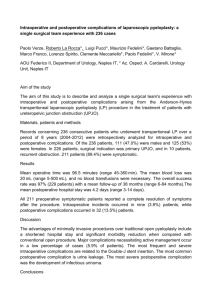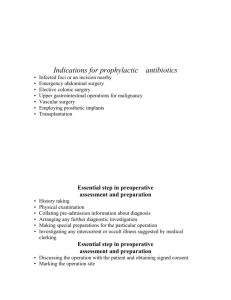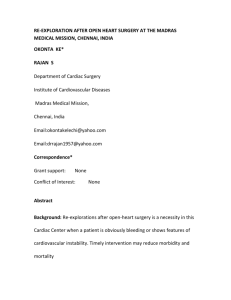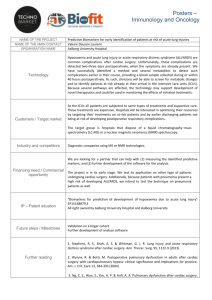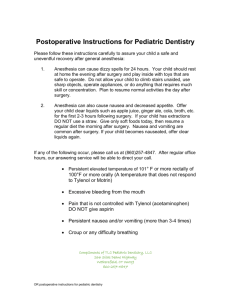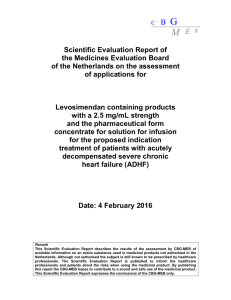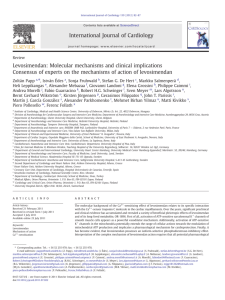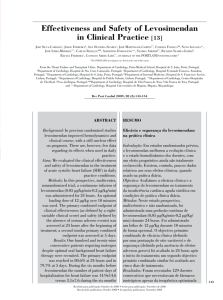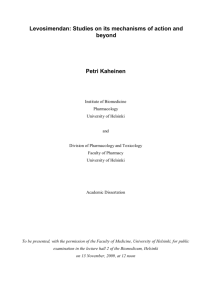Catecholamine and volume therapy for cardiac surgery in
advertisement
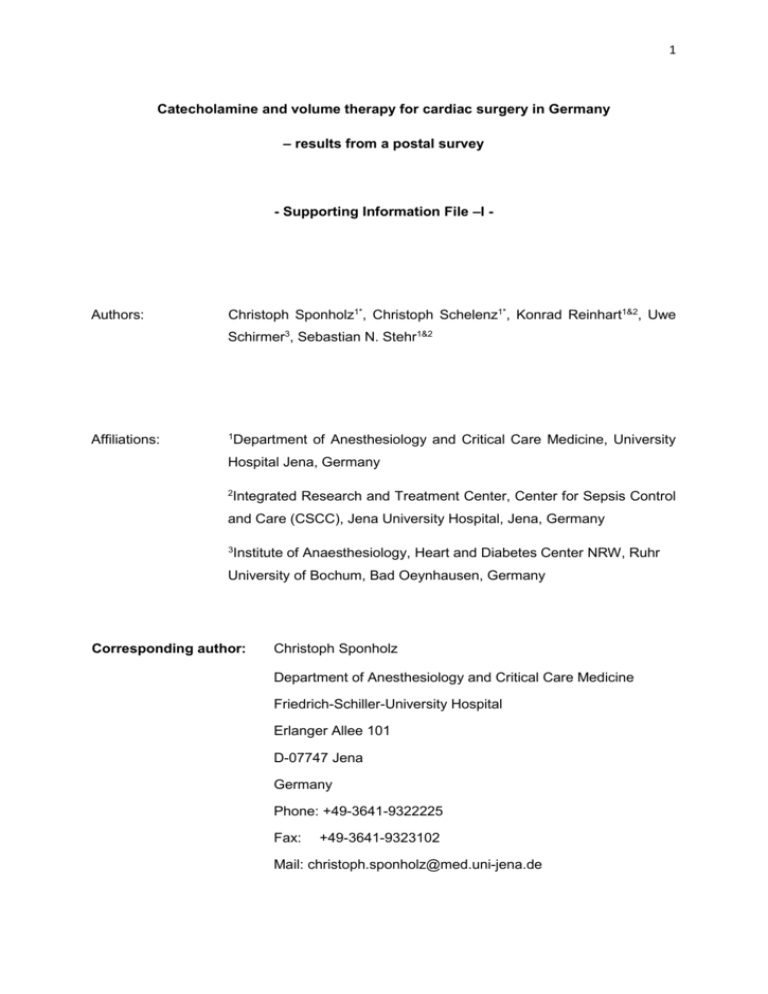
1 Catecholamine and volume therapy for cardiac surgery in Germany – results from a postal survey - Supporting Information File –I - Authors: Christoph Sponholz1*, Christoph Schelenz1*, Konrad Reinhart1&2, Uwe Schirmer3, Sebastian N. Stehr1&2 Affiliations: 1 Department of Anesthesiology and Critical Care Medicine, University Hospital Jena, Germany 2 Integrated Research and Treatment Center, Center for Sepsis Control and Care (CSCC), Jena University Hospital, Jena, Germany 3 Institute of Anaesthesiology, Heart and Diabetes Center NRW, Ruhr University of Bochum, Bad Oeynhausen, Germany Corresponding author: Christoph Sponholz Department of Anesthesiology and Critical Care Medicine Friedrich-Schiller-University Hospital Erlanger Allee 101 D-07747 Jena Germany Phone: +49-3641-9322225 Fax: +49-3641-9323102 Mail: christoph.sponholz@med.uni-jena.de 2 Questionnaire hemodynamic monitoring, catecholamine and volume therapy in cardiac surgery patients 1. Structural hospital data Total bed capacity: _____ □ heart center □ maximal care hospital□ □ university hospital 2. Number of annual cardiac surgery procedures (not including short procedures like pacemaker- or ICD implantation, wound debridement etc.) □ less than 750 procedures per year □ between 750 and 1000 procedures per year □ between 100 and 1500 procedures per year □ between 1500 and 2000 procedures per year □ more than 2000 procedures per year with CPB _____ % sole coronary surgery _____ % 3. Management of postoperative intensive care? □ Anaesthesiology □ Cardiac surgery □ Interdisciplinary 4. Standard operating procedure (SOP) for perioperative catecholamine use ? intraoperative □ yes □ no postoperative □ yes □ no □ unkown (in case of surgical postoperative intensive care) 3 5. Lower mean arterial- or systolic blood pressure limit, prior to intervention (volume challenge or catecholamine use) □ yes mean arterial- or systolic blood pressure _____ mmHg □ yes, but in relation to comorbidities (e.g. carotid stenosis, long-lasting arterial hypertension) Please provide the lowest tolerated mean arterial- or systolic blood pressure without presence of comorbidities ____ mmHg Please provide the lowest tolerated mean arterial- or systolic blood pressure with presence of comorbidities ____ mmHg □ no 6. Which monitoring devices for intraoperative macrohemodynamic control/global perfusion are available (multiple answers possible)? □ transesophageal echocardiography □ PA Catheter □ calibrated trend monitoring device (e.g. PiCCO) □ non-calibrated trend monitoring device (e.g. Vigileo) □ esophageal doppler (e.g. CardioQ) □ other: _______ □ none or seldom intraoperative monitoring 4 7. Please provide the frequency of the intraoperative use of the following hemodynamic monitoring devices Is always present 1 2 3 4 Basic monitoring (e.g. invasive arterial blood pressure) Central venous pressure Transesophageal echocardiography PA Catheter calibrated trend monitoring device (e.g. PiCCO) non-calibrated trend monitoring device (e.g. Vigileo) esophageal doppler (e.g. CardioQ) other: _______ 8. Is a special monitoring device for regional perfusion control or for oxygen consumption available? □ yes □ cerebral oxymetry □ gastric tonometry □ continuous central venous ScvO2 □ continuous mixed venous SvO2 □ other: ______ □ no Is never present 5 5 9. Please provide the frequency of the intraoperative use of the regional perfusion monitoring devices Is always present 1 2 3 4 Is never present 5 4 Is never present 5 cerebral oxymetry gastric tonometry continuous central venous ScvO2 continuous mixed venous SvO2 other: ______ 10. Volume therapy is mainly performed Is always present 1 2 3 Clinically (e.g. pulse pressure variation) Based on filling pressures a) CVP b) wedge pressure By transesophageal echocardiography By calibrated or non-calibrated trend monitoring devices By diuresis 11. According to the CAPS-Care Study (J Card Surg 2011): How often is a catecholamine therapy initiated in cardiac surgery patients ? □ in 80 - 100 % of all patients □ in 60 - 80 % of all patients □ in 40 - 60 % of all patients □ in less than 35 % of all patients 6 12. Which is the first line catecholamine in hypotensive patients caused by low cardiac output syndrome? □ Cafedrine/Theodrenaline □ Dopamine □ Dobutamine □ Ephedrine □ Epinephrine □ Phenylephrine □ Norepinephrine □ Phosphodiesterase Inhibitors □ Levosimendan □ Vasopressin □ Methylene blue 13. Which is the first line catecholamine in hypotensive patients caused by vasoplegia (e.g. under ACE-inhibitor therapy or SIRS)? □ Cafedrine/Theodrenaline □ Dopamine □ Dobutamine □ Ephedrine □ Epinephrine □ Phenylephrine □ Norepinephrine □ Phosphodiesterase inhibitors □ Levosimendan □ Vasopressin □ Methylene blue 7 14. In case of no or only marginal success and optimal volume balance or under first line catecholamine therapy, which second line catecholamine is used? □ None □ Cafedrine/Theodrenaline □ Dopamine □ Dobutamine □ Ephedrine □ Epinephrine □ Phenylephrine □ Norepinephrine □ Phosphodiesterase inhibitors □ Levosimendan □ Vasopressin □ Methylene blue □ Oher: ____________ 15. Is or was your catecholamine therapy influenced by others (cardiac surgery, pharmacy, controlling) ? □ no □ yes 16. Colloids are used intraoperatively .... □ (nearly) always □ often □ less often □ never 8 17. Which is the standard intraoperative colloidal fluid? □ Albumine □ HES products □ Gelatine □ Fresh frozen plasma (FFP) □ none, we always use crystalloids 18. How frequently do you use colloids intraoperatively? always 1 2 3 4 never 5 Albumine HES Gelatine FFP Only crystalloids 19. Is the CPB also primed with colloids ? □ yes, with ... □ Albumine □ HES □ Gelatine □ no 20. Presence of a standard operating procedure (SOP) for perioperative transfusion of packed red blood cells? intraoperative □ yes □ no postoperative □ yes □ no □ unkown (in case of surgical postoperative intensive care) 9 21. How often do you use colloids in the postoperative period? always 1 2 3 4 never 5 Albumine HES Gelatine FFP Only crystalloids 22. Regular use of Multiplate in patients under double platelet inhibition? □ yes □ no 23. Do you regularly discontinue a double platelet inhibition prior to elective cardiac surgery ? □ yes, for _____ days □ no
